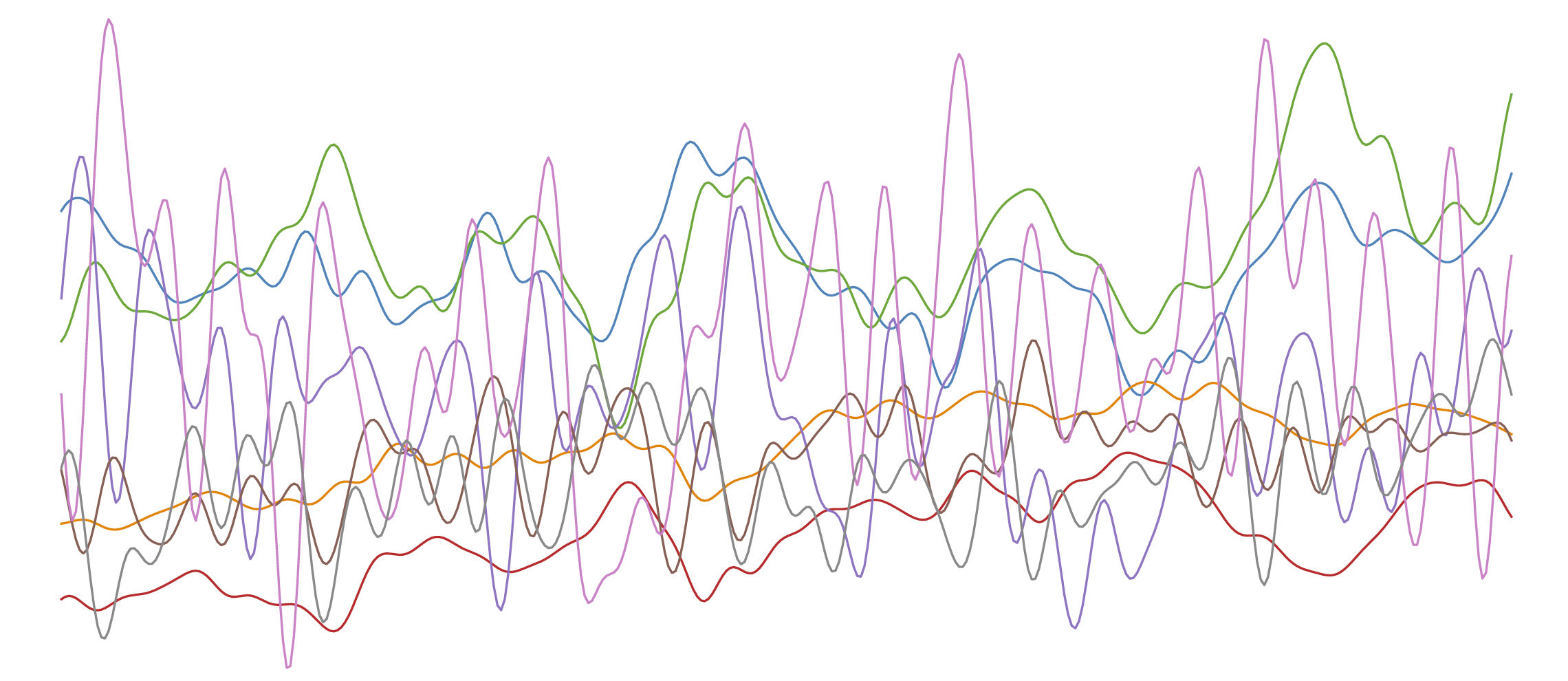NIRS-X & fNIRS2MW Audio n-back dataset
# Publications
The paper describing our latest dataset and algorithms can be found here:
Empower Real-World BCIs with NIRS-X: An Adaptive Learning Framework that Harnesses Unlabeled Brain Signals
Wang, Liang and Zhang, Jiayan and Liu, Jinyang and McKeon, Devon and Brizan, David Guy and Blaney, Giles and Jacob, Robert JK
To appear in the Proceedings of the 37th Annual ACM Symposium on User Interface Software and Technology, 2024
Please cite our papers if you find these datasets (fNIRS2MW-Visual and fNIRS2MW-Audio) useful:
@inproceedings{wang2021taming,
title={Taming fNIRS-based BCI input for better calibration and broader use},
author={Wang, Liang and Huang, Zhe and Zhou, Ziyu and McKeon, Devon and Blaney, Giles and Hughes, Michael C and Jacob, Robert JK},
booktitle={The 34th Annual ACM Symposium on User Interface Software and Technology},
pages={179--197},
year={2021}
}
@inproceedings{huangfNIRS2MW2021,
title = {The Tufts fNIRS Mental Workload Dataset & Benchmark for Brain-Computer Interfaces that Generalize},
booktitle = {Proceedings of the Neural Information Processing Systems (NeurIPS) Track on Datasets and Benchmarks},
author = {Huang, Zhe and Wang, Liang and Blaney, Giles and Slaughter, Christopher and McKeon, Devon and Zhou, Ziyu and Jacob, Robert J. K. and Hughes, Michael C.},
year = {2021},
url = {https://openreview.net/pdf?id=QzNHE7QHhut},
}
@inproceedings{wang2024empower,
title={Empower Real-World BCIs with NIRS-X: An Adaptive Learning Framework that Harnesses Unlabeled Brain Signals},
author={Wang, Liang and Zhang, Jiayan and Liu, Jinyang and McKeon, Devon and Brizan, David Guy and Blaney, Giles and Jacob, Robert JK},
booktitle={Proceedings of the 37th Annual ACM Symposium on User Interface Software and Technology},
pages={1--16},
year={2024}
}
Welcome to the Tufts fNIRS to Mental Workload (fNIRS2MW) audio n-back open-access dataset!
Using this dataset, we can train and evaluate machine learning classifiers that consume a short window (30 seconds) of multivariate fNIRS recordings and predict the mental workload intensity of the user during that interval.
In the previous fNIRS2MW dataset link to it We have collected fNIRS brain activity recordings from 68 partipants during a series of controlled visual n-back experimental tasks designed to induce working memory workloads of varying relative intensity.
We collect and present a novel audio $n$-back fNIRS mental workload dataset with 53 users, expanding upon the previously-released visual $n$-back dataset.add link to it here
This work lends credence to our underlying claim that we are truly measuring short-term memory in a general way, rather than some superficial or perceptual phenomenon tied to the presentation modality. It thus supports the viability of transferring knowledge between the visual and audio tasks, not just across users.
# Quick Links
- Dataset files on Box.com (opens new window)
- Dataset License: CC-By-4.0 (opens new window)
- Code on Github (opens new window)
Jump to: [Project Motivation] | [Dataset Summary] | [Publications] | [Data Collection Procedures]
If you have any questions, please reach out to Leon (leonwang(at)cs.tufts.edu)
# Project Motivation
Brain-Computer Interfaces (BCIs) using functional near-infrared spectroscopy (fNIRS) hold promise for future interactive user interfaces due to their ease of deployment and declining cost. However, they typically require a separate calibration process for each user and task, which can be burdensome. Machine learning helps, but faces a data scarcity problem. Due to inherent inter-user variations in physiological data, it has been typical to create a new annotated training dataset for every new task and user.
To reduce dependence on such extensive data collection and labeling, we present:
- an adaptive learning framework, NIRS-X, to harness more easily accessible unlabeled fNIRS data. NIRS-X includes two key components: NIRSiam and NIRSformer. We use the NIRSiam algorithm to extract generalized brain activity representations from unlabeled fNIRS data obtained from previous users and tasks, and then transfer that knowledge to new users and tasks. In conjunction, we design a neural network, NIRSformer, tailored for capturing both local and global, spatial and temporal relationships in multi-channel fNIRS brain input signals. By using unlabeled data from both a previously released fNIRS2MW visual $n$-back dataset and a newly collected fNIRS2MW audio $n$-back dataset, NIRS-X demonstrates its strong adaptation capability to new users and tasks. Results show comparable or superior performance to supervised methods, making NIRS-X promising for real-world fNIRS-based BCIs.
- a novel audio 𝑛-back fNIRS mental work- load dataset with 53 users, expanding upon the previously-released visual 𝑛-back dataset.
*Just like the previous fNIRS2MW visual n-back dataset (opens new window):
We provide rich demographic information for each subject (age, gender, race, handedness) which enables auditing the "fairness" of fNIRS classifier performance across subpopulations. We view such audits as essential to make sure BCI works for everybody.
Our dataset is targeted at everyday BCI. Our headband-mounted sensor is non-intrusive and easy to put on / take off when performing everyday tasks. It does not require a fabric cap covering the whole skull (like many alternatives) and does not require any complicated registration to landmarks.
# Dataset Summary
For each participant (52 recommended; 53 total), the dataset contains the following records obtained during one 30-60 minute experimental session. Each subject contributes just over 21 minutes of fNIRS data from the desired audio n-back experimental conditions, with remaining time related to rest or instruction periods.
fNIRS recordings
- a multivariate time-series representing brain activity throughout the session, recorded by a sensor probe placed on the forehead and secured via headband
- All measurements are recorded at a regular sampling rate of 5.2 Hz.
- At each timestep, we record 8 real-valued measurements, one for each combination of 2 measured concentration changes (oxygenated hemoglobin and deoxygenated hemoglobin), 2 optical data types (intensity and phase), and 2 spatial locations on the forehead. The units of each measurement are (change in) micro-moles of (oxy-/deoxy-)hemoglobin per liter of tissue.
Activity labels
- Annotations of the experimental task activity the subject performed throughout the session, including instruction, rest, and active experiment segments.
- We label each segment of the active experiment as one of four possible n-back working memory intensity levels (0-back, 1-back, 2-back, or 3-back). Increased intensity levels are intended to induce an increased level of cognitive workload.
Demographics
- The participant’s age, gender, race, handedness, and other attributes. This lets us measure and audit performance by subpopulation (e.g. how does the classifier perform on white subjects vs. black subjects).
Activity performance
- We record the participant’s correctness at the working memory tasks (did they correctly identify when the stimuli was the same as one from n steps ago?). This lets us assess data quality and enforce eligibility criteria.
# Sliding window fNIRS data for classifiers
*In previous fNIRS2MW visual n-back dataset (opens new window) * To improve analysis speed and reproducibility, we also make available a preprocessed version of the data that was used in all our reported experiments. We applied bandpass filtering to remove artifacts, and extracted sliding windows of length 30 seconds and stride 0.6 seconds (3 timesteps).
In our newly paper, we want to introduce band pass filter as a data augmentation method to maximumly utilize unlabeled data. Here we ofer two versions of the fNIRS2MW audio n-back dataset: non-band-pass-filted and band pass filted. Both of them are available in the form:
1. window length: 150 timestamps;
2. stride: 3 timestamps;
Screenshot of the first few lines of the CSV from one subject's data: 
Each row of the CSV file represents the fNIRS sensor measurements at one timestep.
There are 2 columns used as keys and labels:
chunk: indicating the index of the window (the window index increments by one as time goes on)label: indicating if the intensity level, either 0/1/2/3
All rows with the same chunk id represent the time series for a specific individual window. This window of measurements is the input to our classifier.
There are 8 measurement columns, which we use as features for machine learning classifiers:
- AB_I_O, AB_PHI_O, AB_I_DO, AB_PHI_DO
- CD_I_O, CD_PHI_O, CD_I_DO, CD_PHI_DO
Each column is a separate measurement of a hemoglobin concentration in the blood moving through the user's brain. Measuring the changes in these blood oxygen concentrations over time can be a useful proxy of mental workload intensity. The units of each measurement are μmol/L (micromoles per liter).
The feature names here indicate:
- which sensor location on the forehead was used (AB or CD)
- which optical measurement type was used (I = intensity, PHI= phase)
- which blood oxygen concentration was being measured (O = oxygenated hemoglobin; DO = deoxygenated hemoglobin)
Note: Our box.com data release also offer other window sizes (2, 5, 10, 20, 30, and 40 seconds) if desired. We focused on the 30-second windows, which we identified as preferred.
# Publications
The paper describing our dataset and related new techniques to utilize unlabeled brain activity data will be found here:
# Data Collection Procedures
# IRB and COVID-19 Safety Approval
Procedures to collect data were approved by Tufts institution's IRB (opens new window), and our deidentified dataset was approved for public release (STUDY00000959). Each participant gave informed written consent, and was compensated $20 US.
Because collection occurred during the COVID-19 pandemic in 2021 and 2022, we also got approval from the Tufts Integrative Safety Committee (ISC). We followed required sanitation and social distancing practices: experimenters used personal protective equipment and disinfected the fNIRS probe for each subject.
# Task Description
- Each participant completed
16blocks of n-back trails (0→1→2→3→1→2→3→0→2→3→0→1→3→0→1→2). - Each block is composed of:
40trails ( audio length of each number is0.5seconds, then pause for1.5seconds ).
Details of task sessions is as below: 
# Task introduction
N-back video introduction:
Before experiment started, the system played a short introductory video, showing an example of a user completing n-back tasks, with voice-over and caption explanations.
Sample scripts for N-back task video are as below:
Today you will be completing a series of n-back tasks. You will be presented with many numbers, one after another. Some of these numbers will be targets. A number is a target if it is identical to the one shown n steps previously.
Here is an example of a 2-back task. In this case, n = 2. The highlighted 8 is a target number, since the number 2 steps back is also 8.
Your job will be to press the left arrow key each time you hear one of these target numbers. If the number played is not a target number, you should press the right arrow key.
Let’s view an example of a 0-back task.
At the beginning of each task, you will hear a few beeps which indicate the start of the task.
The current type of n-back task can be found at the top of the task window. In this example, n = 0. For the purposes of this demo only, the stack of numbers already shown is included beneath the task window.
When n = 0, every number is a target, since every number is identical to the number 0 steps back. That is, every number is the same as itself. For 0-back, the participant presses the left arrow key after each number appears, and never presses the right arrow key.
Now let’s view an example of a 1-back task.
The participant should press the right arrow key for all non-target numbers. When n = 1, a number is only a target if it is identical to the number 1 step back. Once the participant identifies a target number, they should press the left arrow key instead.
For example, this 4 is a target number because the previous number was also 4. The participant should press the left arrow key, and then continue pressing the right arrow key until they hear the next target number.
Here is another target number. The number 1-step back was also 2, so the participant should press the left arrow key.
During today’s experiment, the stack of already played numbers will not be available to you. It is your job to remember the numbers that were n-steps back so that you are able to identify the correct target numbers.
There will be 16 rounds in total. During each round, you will complete an n-bask task, where n is either 0, 1, 2, or 3.
Before each task, there will be instructions reminding you how to find the target numbers for the current n. During the task, you will hear total 40 numbers audio recordings. Each time you hear a target number, you should press the left arrow key. For all non-target numbers, you should press the right arrow key.
After each task, you will complete a survey. Once you have completed the survey, you will be able to rest for 20 seconds.
The experiment will take approximately 40 minutes.
After the entire experiment is finished, you will complete a short interview about your experience.
Please remain seated and do not talk or adjust the headband while completing the experiment. However, if you do feel uncomfortable at any point, let the operator know and they will stop the experiment.
Generel introduction: Before each task, the system displayed a graphic depicting how to identify targets for the current n, with voice-over.
The graphic and sample scripts for 0-back are as below:
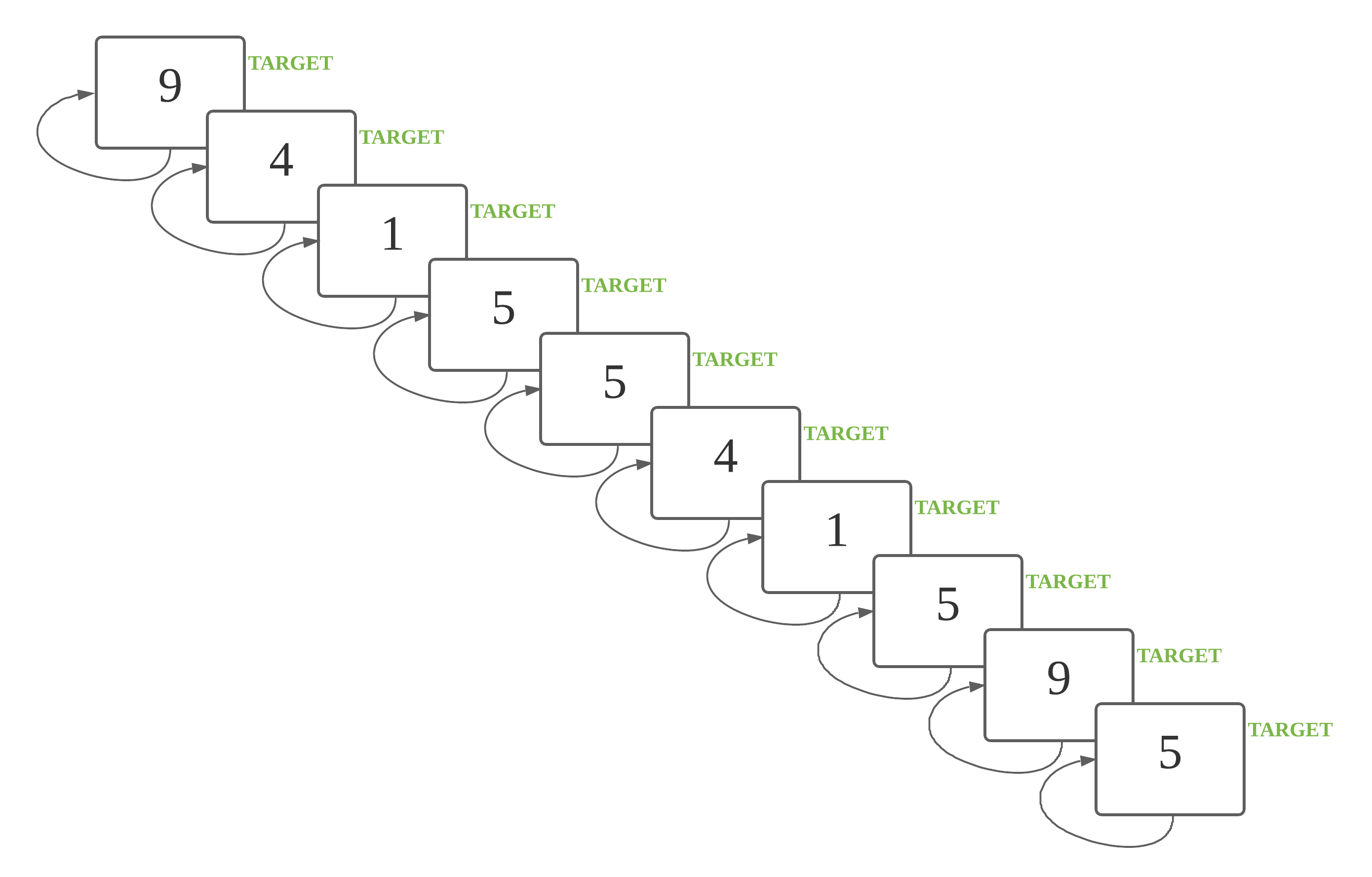
This is a 0 back task. Every number is a target number.
The graphic and sample scripts for 1-back are as below:
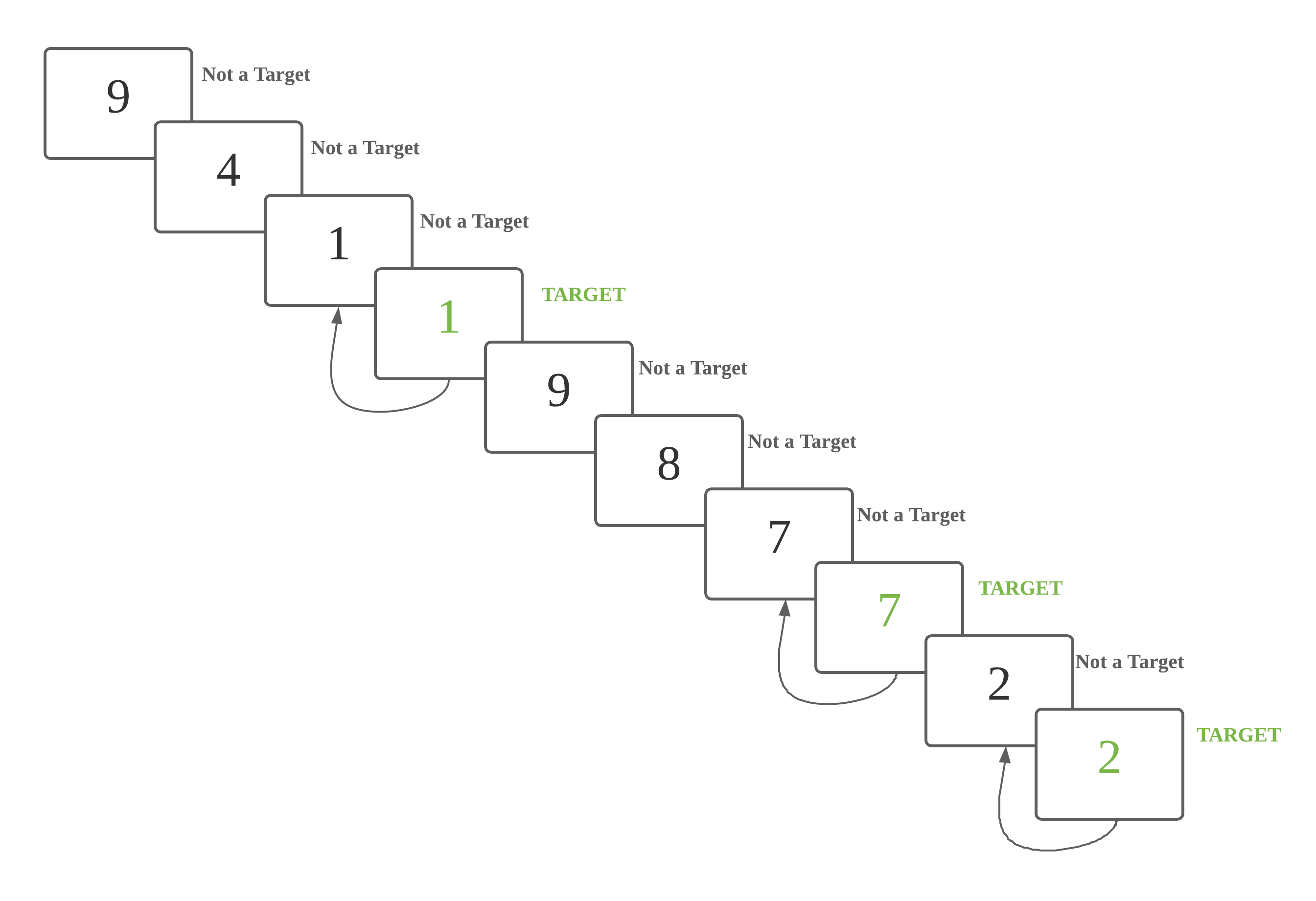
This is a 1 back task. A number is a target if it is identical to the previous number.
The graphic and sample scripts for 2-back are as below:
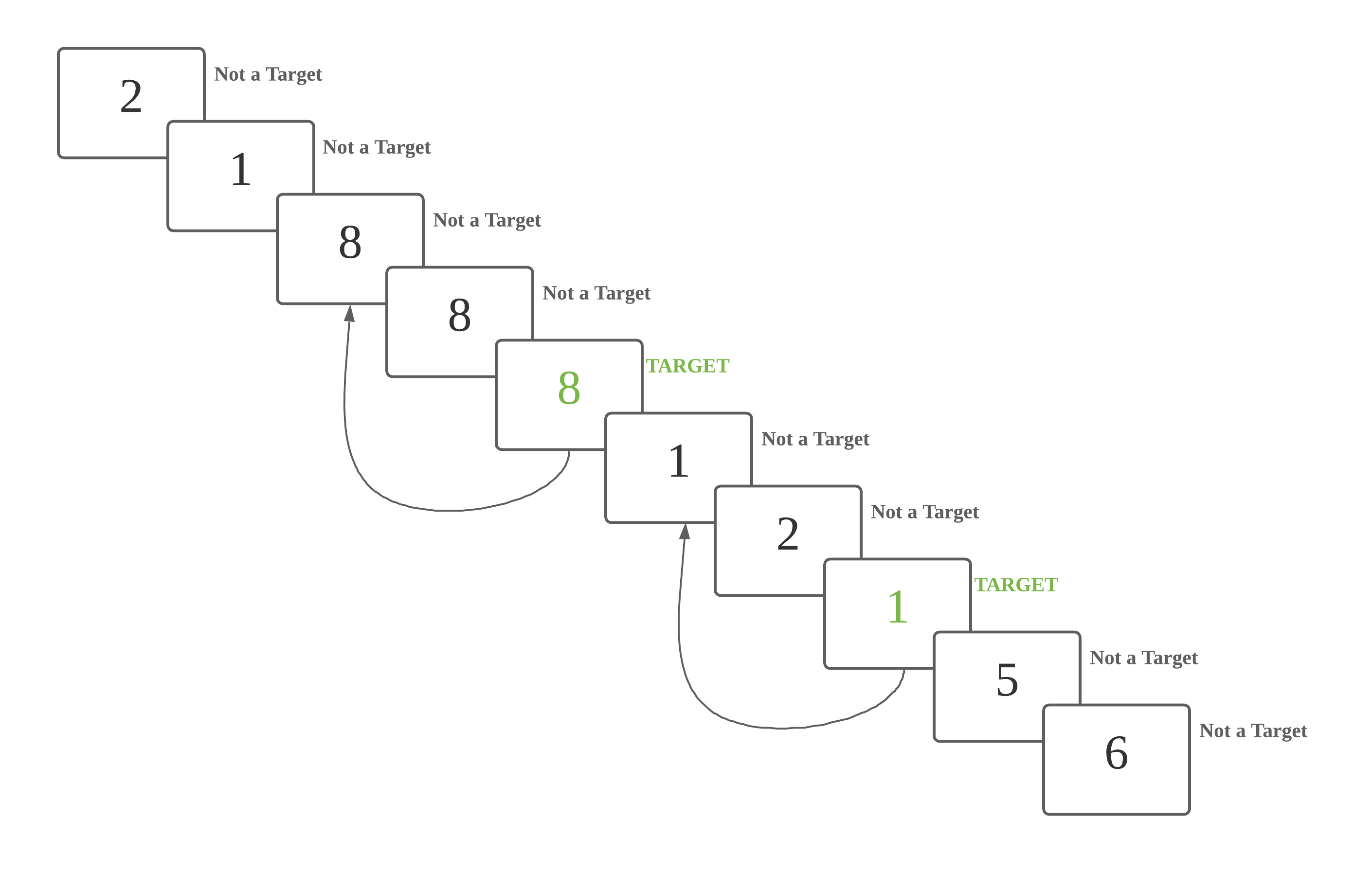
This is a 2 back task. A number is a target if it is identical to the number 2 steps back.
The graphic and sample scripts for 3-back are as below:
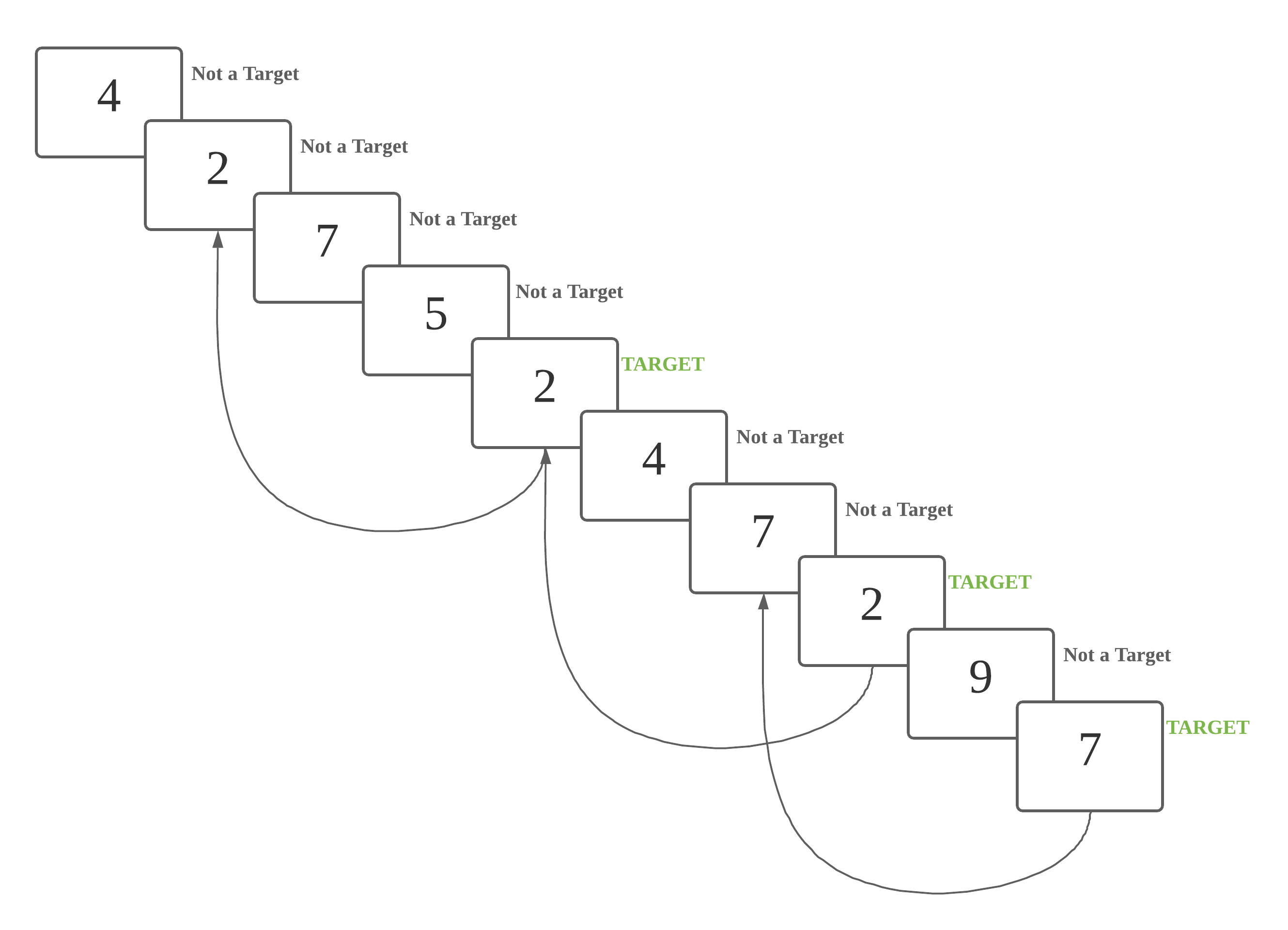
This is a 3 back task. A number is a target if it is identical to the number 3 steps back.
# Data Structure
Our released dataset includes (Link to fNIRS2MW audio n-back dataset (opens new window)):
- fNIRS measurements in raw audio n-back fNIRS_data (opens new window);
- Supplementary data:
- demographic and contextual information in pre-experiment (opens new window);
- Cognitive task performance in task_accuracy (opens new window);
- experiment log in log (opens new window);
- post-experiment interview in interview (opens new window);
- subjective workload in nasa-tlx (opens new window);
***************************************
** fNIRS2MW audio n-back dataset folder structure **
***************************************
|- qualified_subjects_list.pdf //
|- pre-experiment //
|- experiment //
| |- log //
| |- task_accuracy //
| |- raw_data //
| |- band_pass_filtered //
| | |- whole_data //
| | |- bpf_size_10ts_stride_03ts //
| | |- bpf_size_25ts_stride_03ts //
| | |- bpf_size_50ts_stride_03ts //
| | |- bpf_size_100ts_stride_03ts //
| | |- bpf_size_150ts_stride_03ts //
| | |- bpf_size_200ts_stride_03ts //
| |- non_band_pass_filtered //
| | |- whole_data //
| | |- size_150ts_stride_03ts //
|- post-experiment //
| |- nasa-tlx //
| |- interview //
| |- * (all other folders) //
# Data Format
We introduce and describe the data format of fNIRS data (raw and pre-processed) and supplementary data as below:
# experiment Data (opens new window)
53 participants were recruited, aged 18 to 33 years. None of the participants reported neurological, psychiatric, or other brain-related diseases that might affect the result.
# raw data (opens new window)
TODO
# band pass filtered data (opens new window)
After pre-processing (Dual-slope and band pass filter), we have features/columns as below:
label: The label for each row.
- The values shoule be in the set {0, 1, 2, 3}, representing 0-back/1-back/2-back/3-back tasks respectively.
- It should be the same for all rows in the same chunk.
chunk (Only in slide window data): The chunk number for each chunk.
- It starts at
0and increases by1for each chunk. - It should be the same for all rows in the same chunk.
- It starts at
AB_I_O, AB_I_DO: Intensity of oxy & deoxy from detector AB.
CD_I_O, CD_I_DO: Intensity of oxy & deoxy from detector CD.
AB_PHI_O, AB_PHI_DO: Phase of oxy & deoxy from detector AB.
CD_PHI_O, CD_PHI_DO: Phase of oxy & deoxy from detector CD.
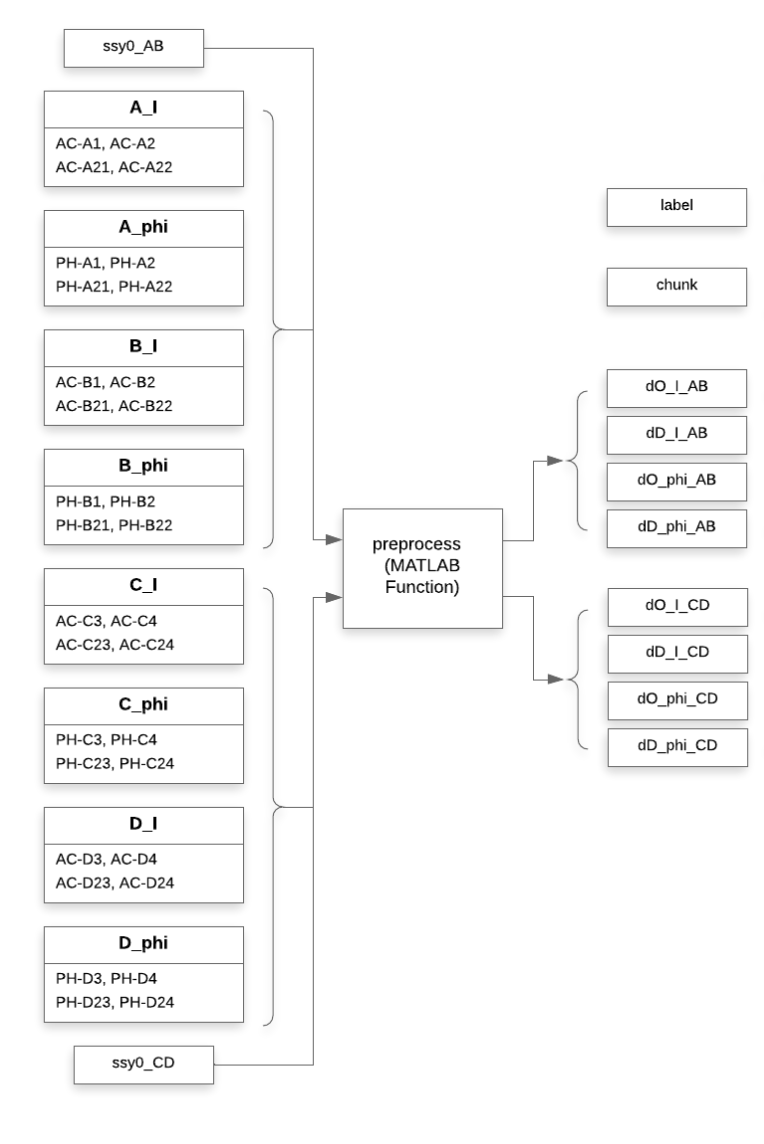
# non bpf whole data (opens new window)
# bpf whole data (opens new window)
Each subject's .csv file includes continuous data of 16 tasks (exclude data during self-evaluation (nasa-tlx) and rest period).
# slide window data (opens new window)
We offer pre processed data in :
- Window size:
10/25/50/100/150/200timestamps (2/5/10/20/30/40seconds) - Window stride:
3timestamps (rough0.6second)
# Supplementary Data
To ensure quality and consistency, we used several criteria to identify which subjects' data are suitable for classifier evaluation.
# demographic and contextual information (opens new window)
Demographic and contextual information is recorded before the experiment.
Please see details in the data directly
# task_accuracy (opens new window)
We measured the subject's performance at the n-back task based on the accuracy of the subject's response for each digit.
the accuracy of each n-back task was recorded.
# nasa-tlx (opens new window)
This is a good way to evaluate the perceived/subjective mental workload.
Total 16 "serial_feedback" .csv files for 16 n-back tasks:
12files start with "train_1_1_" (1-12) match the first1-12tasks,4files start with "test_1_2_" (1-4) match the last4tasks.- Useful features include:
- movement: subject report if the headband is moved or not,
- uncomfortable: subject report if feeling unfortable during the experiment or not,
- mental: mental workload after the task from low (
0) to high (100) - performance: performance after the task from low (
0) to high (100) - effort: effort needed for the task from low (
0) to high (100) - frustration: frustration felt during the task from low (
0) to high (100)
# log (opens new window)
Hair blocking, light leaking, fNIRS instrument settings and other issues during the experiment were recorded.
# interview (opens new window)
Post-experiment interviews were converted from audio to text (pdf version) by the operator.
The original audios were destroyed immediately following the IRB protocol.

